Sphinginae subfamily
Sphingini tribe:
 |
Agrius cingulata, WO Pink-spotted hawkmoth:
Larvae feed on plants in the Convolvulaceae family, especially Ipomoea batatas (sweet potato) and in the Solanaceae family,
especially (Datura) (jimsonweed) and related plants in the Americas. There is also a brown form. Look for very large, dark spiracular circles.
|
 |
Ceratomia amyntor
WO, Elm Sphinx or Four-horned Sphinx
Larvae feed on Elm (Ulmus), birch (Betula), basswood
(Tilia), and cherry (Prunus).
There are both green and brown forms. The four horns near
the head are diagnostic. |

|
Manduca quinquemaculatus
WO, Five-spotted Hawkmoth:
The caterpillars are called Tomato Hornworms and each has a black horn at the end of the abdomen.
Larvae feed on potato, tobacco, tomato, and other plants in the
nightshade family (Solanaceae). There is also a very beautiful brown form. See bottom of page.
|
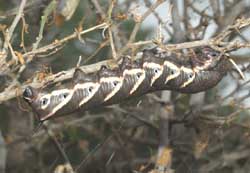
|
Manduca quinquemaculatus WO, the Five-spotted Hawkmoth:
The caterpillars are called Tomato Hornworms and each has a black horn at the end of the abdomen.
Larvae feed on potato, tobacco, tomato, and other plants in the
nightshade family (Solanaceae). There is also a very beautiful brown
form to the left.
|
 |
Manduca rustica
WO, the Rustic Sphinx:
The caterpillar has numerous white nodules on top of the thorax and
seven pairs of oblique, blue-gray stripes along the side of the body.
The horn is white at the base and blue-gray at the tip. Many hosts
are utilized.
|
 |
Tobacco Hornworms, equipped with a red-tipped horn at the end of the
abdomen, are true gluttons and feed on tobacco and tomato, and
occasionally potato and pepper crops and other plants in the
nightshade family (Solanaceae).
|
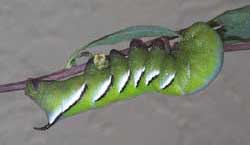 |
Larval hosts are unknown, but larvae probably feed on Lycium
in the nightshade family (Solanaceae).
Note the strong oblique black lines and the black anal horn.
|
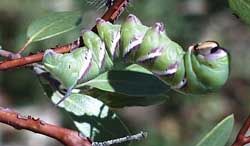 |
Larval hosts are Manzanita
and Arctostaphylos of the Ericaceae family.
Note the purple on both sides of the oblique white lines, the pale
blue horn, brown head and purple feet.
|
 |
Sphinx chersis
WO, the Great Ash Sphinx:
The larvae are pale bluish green. The head has a pair of yellow
lateral bands meeting at the apex.
Larval hosts are ash, lilac, privet, cherry, and quaking aspen.
|
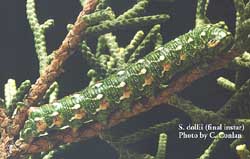 |
Sphinx dollii
WO, the Doll's sphinx: Larval hosts are Alligator juniper (Juniperus deppeana)
and other juniper species. It is amazing to me how well the larval spiracular patches and false feet match
the pattern and colour of the juniper bark.possibly |
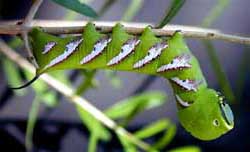 |
Sphinx libocedrus WO, Incense Cedar Sphinx: Larvae feed on New Mexican forestiera
(Forestiera neomexicana), on Forestiera angustifolia
and on little leaf ash (Fraxinus gooddingii) in the Oleaceae
family. There are green and dark forms and all larvae tend to darkenjust before pupation.
|
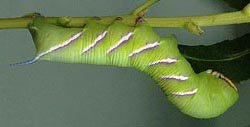 |
Sphinx perelegans
WO, Elegant Sphinx; Unique feature: shield on first thoracic
segment, which is of same colour as body and which forms tight-fitting hood over vertex of head, hiding pair of
glossy black spots on top of head, which are revealed if animal is disturbed. questionable |
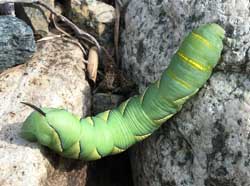 |
Sphinx vashti
WO, the Snowberry Sphinx: Larvae feed on the common snowberry (Symphoricarpos albus)
and on coralberry (S. orbiculatus). Note the two golden lines
of slightly raised bumps, one just behind the head, the other on the thorax.
generally more northerly
|
Smerinthini Tribe:
 |
Pachysphinx modesta
WO,
the Modest Sphinx or Poplar Sphinx
Larvae feed on poplars and cottonwood.
|
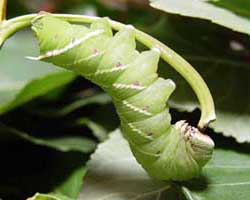 |
Larvae feed on cottonwood and poplar (Populus) and willow
(Salix). I suspect this species is the more likely of the two
Pachysphinx to fly in McKinley County.
Larvae are very chunky with little to distinguish them
from Pachysphinx modesta.
|
 |
Larvae accept willows, birches, and cherries.
I have also found them in the wild on oak in eastern Canada.
Larval skin is rough and grainy.
generally more eastern species |
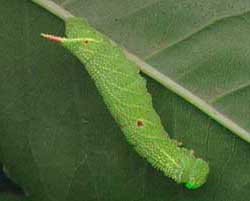 |
Wild cherry species are the favorites as larval
foodplants, but eggs will also be deposited on birches and other
forest trees. To the left a second/third instar larva rests on pin
cherry.
The "red heart" marking readily identifies this species.
generally more eastern species; possibly |
 |
Smerinthus cerisyi WO, Cerisy's Sphinx;
Greatly resemble modesta larvae, pale
green, granular skin, pale lateral diagonal lines, faint red
spiracular circles, very pale longitudinal lines running from
head to more pronounced anal diagonal line.
Larvae have green heads bounded dorsally with pale yellow
inverted "V".
|
 |
Larvae feed upon many forest trees including birches and cherries,
but are expecially fond of poplars and willows. Red markings on sides
vary greatly from specimen to specimen.
|
Macroglossinae subfamily
Dilophonotini tribe:
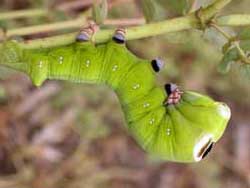 |
Larvae feed on papaya (Carica papaya), Cnidoscolus
angustidens, poinsettia (Euphorbia pulcherrima),
guava (Psidium species) and
saffron plum (Bumelia angustifolia/Bumelia celastrina).
Manilkara bahamensis,
Willow Bustic (Bumelia salicifolia)
and Painted Leaf (Poinsettia heterophylla) are also hosts.
Nice socks! Larvae show considerable variation.
|
 |
Hemaris diffinis
WO, Snowberry Clearwing; Bumblebee Moth:
Larval host plants include Snowberry (Symphoricarpos),
honeysuckle (Lonicera), Coralberry, viburnums, Blue Dogbane
(Apocynum), dwarf bush honeysuckle (Diervilla lonicera).
Horn black, yellow base.
|
Philampelini tribe:
 |
Larvae feed upon Grape (Vitis), Virginia Creeper
(Parthenocissus quinquefolia) and other vines and ivies
(Ampelopsis).
Larvae occur in both a light (green) form and a darker (tan/brown)
form. Note six "segmented" oblique lines.
|
Macroglossini tribe:
 |
Darapsa myron WO, the Virginia Creeper Sphinx or the Grapevine Sphinx
If you have the
foodplants indicated in the common names, you probably have this
species nearby. The lower wings are orange.
Larvae feed on Virginia creeper (Parthenocissus quinquefolia),
Grape (Vitis), Ampelopsis, and Viburnum. |
 |
Hyles lineata
WO, the White-lined Sphinx
Larvae are highly varied and feed on a great diversity of plants
including willow weed (Epilobium), four o'clock (Mirabilis),
apple (Malus), evening primrose (Oenothera), elm
(Ulmus), grape (Vitis), tomato (Lycopersicon),
purslane (Portulaca), and Fuschia.
All larvae seem, however, to have the red/black swellings split by
dorso-lateral lines. |
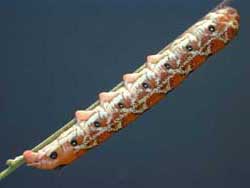
|
Larvae feed on (Onagraceae) including evening primrose
(Oenothera), gaura (Gaura), and willow weed
(Epilobium).
Early instars are green and lack the dark sharply contrasting
spiracular circles and other patterning. possibly, generally more westerly species
|
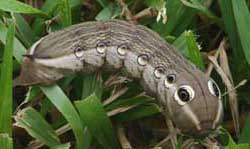 |
Larvae also feed on Borreria, Catalpa and Manettia spp. and
Smooth buttonplant (Spermacoce glabra) and starclusters
(Pentas species). They are also recorded on joe-pie weed and
Hamelia patens and on Hedoydis nigricans. The green form may be more
common.
|
|
|